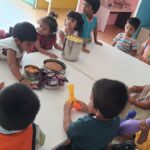At the Child Education Center, learning is made joyful and interactive, especially through activities like building blocks play. These colorful and engaging blocks—available in various shapes, sizes, and textures—are more than just toys. They are powerful educational tools that support a wide range of developmental milestones in early childhood.
Hands-On Exploration and Creativity
When children begin stacking blocks into towers, designing houses, or forming imaginative shapes, they embark on a journey of creativity and self-expression. Without any instructions, children naturally explore their ideas, creating everything from castles to bridges. This open-ended play helps them make decisions, test ideas, and express their imagination freely.
Cognitive and Problem-Solving Skills through building blocks
Building blocks help children understand fundamental concepts in math and science. As they play, they naturally learn about balance, symmetry, height, weight, and patterns. For example, stacking blocks teaches them about stability and gravity—what makes a tower stand or fall.
When something they build topples over, they often try again, adjusting the structure. This trial-and-error process strengthens their problem-solving abilities, encouraging persistence and logical thinking from a young age.
Developing Fine Motor Skills
The act of grasping, lifting, placing, and balancing blocks enhances children’s fine motor coordination and hand-eye coordination. These small muscle movements are essential for future tasks like writing, drawing, and using tools. The more they play, the more control and precision they develop in their fingers and hands.
Social Skills and Teamwork
Block play also promotes social interaction. When children build together, they learn to cooperate, communicate, and share ideas. They often take on roles—one child builds the tower while another gathers the blocks—building early teamwork and leadership skills in the process.
Conclusion: Simple Building blocks Play, Powerful Learning
At our center, building blocks are more than just playthings—they are the building blocks of knowledge. Through stacking, designing, and imagining, children grow in confidence, curiosity, and skill. This activity beautifully combines fun with foundational learning, making it one of the most beloved and beneficial experiences in early education.




